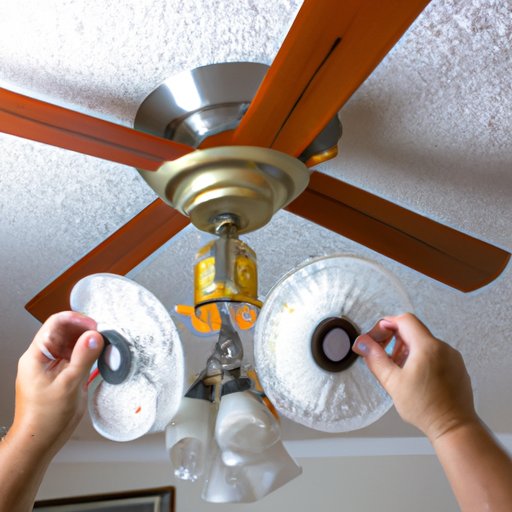Introduction
Installing a ceiling fan can be an effective way to boost home energy efficiency and reduce energy costs. However, before installing one, you need to consider the costs involved. This article will explore the various factors that can affect the cost of installing a ceiling fan, as well as the potential benefits and drawbacks of doing so.

A Breakdown of Average Costs Involved with Installing a Ceiling Fan
When considering the cost of installing a ceiling fan, there are two main options: professional installation or DIY installation. Professional installation typically involves hiring an electrician or contractor to install the fan for you. This can be costly, depending on the complexity of the job and the type of fan you choose. On average, professional installation can range from $150-$450.
DIY installation is generally cheaper, as you don’t have to pay for a professional’s services. However, you’ll still need to purchase the necessary materials, such as screws, wires, and brackets. You may also need to rent special tools for the job. Depending on the type of fan you choose, the cost of DIY installation can range from $50-$200.

Comparing Professional and DIY Installation Costs
When deciding between professional and DIY installation, it’s important to consider the pros and cons of each option. Professional installation comes with the benefit of having an experienced electrician handle the job. This ensures the job is done correctly and safely. However, it can be more expensive than DIY installation.
DIY installation offers the potential for cost savings, as you don’t need to hire a professional. However, it’s important to make sure you have the necessary tools and skills to complete the job safely. If you’re unsure about how to properly install a ceiling fan, it’s best to seek professional help.
Analyzing the Benefits of Installing a Ceiling Fan
In addition to potentially saving money on installation costs, installing a ceiling fan can have other benefits. A ceiling fan can help regulate the temperature in a room by circulating air, which can improve energy efficiency. This can lead to long-term cost savings on energy bills.
Installing a ceiling fan can also add aesthetic value to a room. There are a variety of styles available, ranging from modern and contemporary to traditional and rustic. Choosing the right fan can be a great way to enhance the look of a room.
Understanding Different Types of Ceiling Fans
When selecting a ceiling fan, it’s important to understand the different types available. Standard ceiling fans feature blades that rotate in a circular motion to circulate air. Other types of fans include dual-motor fans, which have two motors to create more airflow; and oscillating fans, which feature blades that move back and forth to create a more gentle breeze.
The cost of installation will vary depending on the type of fan you choose. Standard ceiling fans typically require less time and effort to install, so they tend to be cheaper. Dual-motor fans and oscillating fans require more time and effort, so they tend to be more expensive.

Examining the Pros and Cons of Different Ceiling Fan Installations
When deciding how to install a ceiling fan, it’s important to consider the benefits and drawbacks of each option. Hanging a fan from the ceiling is the most common installation method and is usually the easiest and least expensive option. Wall-mounted fans offer greater flexibility and can be installed in tight spaces, but they require more time and effort to install.
Remote-controlled fans offer convenience, as they can be controlled from afar. However, they tend to be more expensive to install due to the additional wiring required. Finally, flush-mount fans are ideal for low ceilings, but they can be more difficult to install due to the need to mount the fan close to the ceiling.
Conclusion
Installing a ceiling fan can be a great way to save money on energy costs and improve the look of a room. The cost of installation will depend on whether you choose to hire a professional or attempt a DIY installation. Additionally, the type of fan you choose and the installation method will also affect the overall cost. When making your decision, it’s important to consider all of these factors to ensure you get the best possible outcome.


